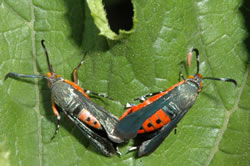  |
| Hawk moths, adult form of the squash vine borer |
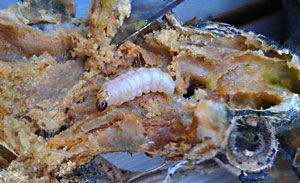 |
| Squash vine borer, larval phase, inside a zucchini stem. Photo by Massiv99. Licensed under CC0 via Wikimedia Commons |
SQUASH VINE BORER
Squash vine borers are showing up in traps, and I saw an adult sitting on one of my butternut squash just a few days ago. Many vine crops are in bloom, and the row covers have been taken off to allow the bees access, and that means the borer now has access too. Care should be taken during bloom to avoid using insecticides when the bees are active.
Squash vine borer moths are day-flying moths with a 1.0 to 1.5 inch wingspan and bright orange markings. In flight, they look like wasps. There is one generation each year and adults emerge in late June/early July. The moths fly slowly in zig-zags around plants and lay eggs singly on stems; eggs are usually found on the main stem near the base, but are also found on leafstalks or on the undersides of leaves. Upon hatching, larvae bore into stems (where they are protected from insecticides). Thick-stemmed squashes are preferred. Unless you use traps or scout fields for evidence of eggs or larvae, the first sign of squash vine borer infestation is often wilting vines in July and August. By that time, it is too late to do anything.
Growers should scout their pumpkin and squash fields weekly for squash vine borer from late June through early August. Examine the base of vines for eggs. The squash vine borer can be killed with an insecticide and the recommendation would be spinosad (for example, Entrust or Monterey Garden Spray), but appropriate timing is crucial. Bt also works, but Bt breaks down more quickly. Bt aizawai (for example Agree WG) has been shown to work better than Bt kurstaki (for example Dipel). Either insecticide is only effective when applied for young larvae to eat before they bore into the stem. Once they are in the stem the insecticide will be useless. If you see the moths flying or find eggs, then two insecticide sprays, ideally applied to the base of the plants and timed five to seven days apart, will control newly hatching larvae before they are able to bore into the stem. Again, the timing is crucial and there is no point in spraying before you find evidence, or after the larvae bore into the stem.
If evidence of larval feeding (sawdust-like frass near entrance holes) is found, then split open the stem to confirm the presence of larvae, which, by the way, may suggest more eggs are being laid so scout. Borers can be removed from vines if detected before much damage is done. Slit the stem longitudinally, remove the borer, then cover the wounded stem with moist soil above the point of injury to promote additional root formation.
Some growers monitor for the moths using Scentry Heliothis pheromone traps from early June through early August. If more than 5 moths per week are captured, then they make 2 to 4 weekly applications of pesticides. Timing is very important, so this is not recommended for the casual gardener.
Source material from New England Vegetable Management Guide; Handbook of Vegetable Pests, A Capinera; ATTRA, UMass Vegetable Newsletter and URI Extension Fact Sheet
Top
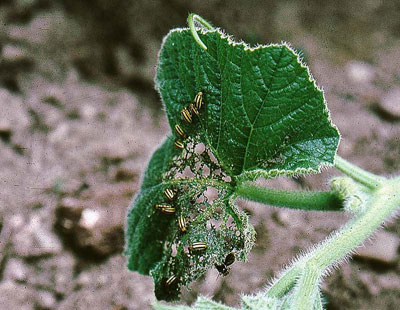 |
| Cucumber beetles. Photo by Eric Sideman. |
STRIPED CUCUMBER BEETLE (Modified from article in Mass. Veg. Notes written by Ruth Hazzard & Andrew Cavanagh)
Striped cucumber beetle is showing up in large numbers this year. Striped cucumber beetle is our most serious early-season pest in vine crops. These beetles spend the winter in plant debris in field edges, and with the onset of warm days and emergence of cucurbit crops, move rapidly into the field. Densities often are very high, especially in non-rotated fields or close to last year’s cucurbit crops. Management cannot wait because adult beetle feeding on seedlings (cotyledons and young leaves) is the most serious, and can cause stand reduction and delayed plant growth. Also, the striped cucumber beetle vectors Erwinia tracheiphila, the causal agent of bacterial wilt, and this may be more damaging than direct feeding injury. Crop rotation, transplants instead of direct seeding, and floating row cover are cultural controls that help reduce the impact of cucumber beetles. By far, floating row covers offer the best results. You must get the row cover on at transplanting or seeding. Early management is important to avoid early season infection with wilt. Cucurbit plants at the cotyledon and first 1-4 leaf stage are more susceptible to infection with bacterial wilt than older plants.
Perimeter trap cropping gives excellent control with dramatic reduction in pesticide use (see 2011 Pest Report for short article).
Beetle numbers should be kept low, especially before the 5-leaf stage. Scout frequently (at least twice per week for two weeks after crop emergence) and treat after beetles colonize the field. Early spot treatments of field edges can be helpful. The threshold depends on the crop. To prevent bacterial wilt in highly susceptible crops, we recommend that beetles should not be allowed to exceed one beetle for every 2 plants. Less wilt-susceptible crops (butternut, most pumpkins) will tolerate 1 or two beetles per plant without yield losses. Spray within 24 hours after the threshold is reached. Proper timing is key.
The best approach is to avoid the beetles with a row cover or the use of Surround (see below for instructions on Surround), but if you missed the arrival of the beetles then pyrethrum (for example Pyganic) should be sprayed very early in the morning, at dawn or before, to catch the beetles before they become active with the day’s warmth, and to give the pyrethrum time to work before the sun degrades it. Evening spraying can work for that, but often the beetles are flighty then and you see them flying up and away as you move down the row. Do not spray during the day when bees are active.
OMRI-listed insecticides available for use in striped cucumber management include kaolin clay (Surround WP), pyrethrum (Pyganic Crop Spray 5.0 EC), and spinosad (Entrust). In 2009 spray trials comparing these three products at the UMass Research Farm, kaolin was the most effective in reducing beetle numbers and feeding damage. There was a trend toward Surround WP being more effective when Pyganic or Entrust was mixed with it, but never significantly better than Surround alone. Other studies have shown more efficacy from pyrethrum and spinosad. Remember, Surround should be applied before beetles arrive because it acts as a repellent and protectant – beetles do not “recognize” the plant and so do not feed – not a contact poison. With direct-seeded crops, apply as soon as seedlings emerge if beetles are active. Transplants can be sprayed or dipped into the solution before setting out in the field.
I heard from a grower who tried out a vacuum and reported that it seemed to work well. He suggests using a vac with a low setting and/or a broad nozzle so that you don’t damage plants. Also, do this earlier in the morning when they are sleepy and slow, and be sure to look in their hiding places under the plants.
Top
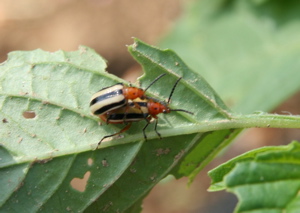  |
| Three-lined potato beetles. Photo by Eric Sideman. |
THREE-LINED POTATO BEETLE
Cucumber beetles on my potatoes and tomatillo? No. Those are not cucumber beetles. Potatoes, tomatoes and sometimes eggplants are attacked by this pest that only superficially looks like a cucumber beetle. The Three-Lined Potato Beetle adult is about the same size as a cucumber beetle, but has a reddish head and a thorax with two dark spots. The wing covers are dark yellow with three black stripes. Its favorite food in my experience is tomatillo.
The Three-Lined Potato Beetle overwinters as an adult and wakes early in the spring. They are there waiting for you to plant your solanaceous crops. The females soon begin laying eggs that hatch in about two weeks to larvae that look a bit like Colorado potato beetle larvae, except these critters have the endearing practice of carrying a small pile of their own excrement on their back. The larvae mature in about two weeks. There are probably two generations per year.
On most crops the level of the pest does not warrant control. If this pest has been a problem in the past, floating row covers will help you avoid the overwintering adults and that should get you by. Hand picking will work on small plantings. Pyganic and Entrust may offer some relief, but in my experience, little. Rotenone works well, BUT REMEMBER THAT THERE ARE NO ROTENONE IS NOT A REGISTERED PESTICIDE ANY MORE, AND SHOULD NOT BE USED.
Top
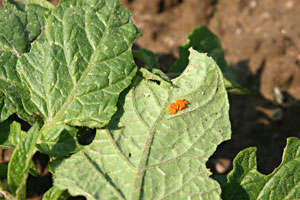 |
| Colorado potato beetle eggs |
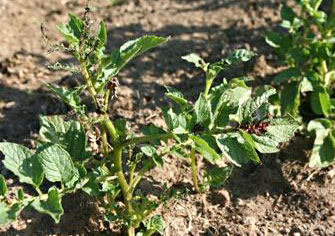 |
| CPB larvae and leaf damage |
 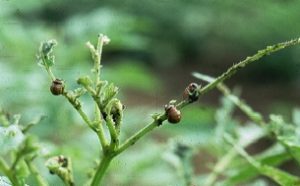 |
| Colorado potato beetle larvae – 4th instar. Photo by Eric Sideman. |
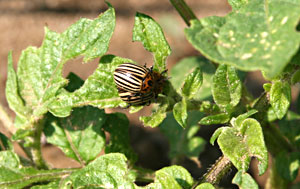 |
| Adult Colorado potato beetles |
COLORADO POTATO BEETLE (Leptinotarsa decemlineata)
Colorado potato beetles (CPB) adults are in potato and eggplant crops. They have been laying bright yellow eggs in clumps with about 30-35 eggs each, generally on the undersides of leaves. These have hatched and the larvae are eating your crop.
Scouting and Thresholds
Walk your fields soon and look for CPB adults and eggs. Look on the undersides of leaves for the orange-yellow egg masses. The fresher the eggs, the brighter orange the eggs will appear. Eggs hatch in 7-10 days, depending on temperature. If you want to know when the earliest eggs are hatching, you can flag a few of the earliest egg masses you find with bright tape or flags, and then keep an eye on the hatch.
Hatched larvae go through four stages before they become adults. In the first stage, the larvae are about the same size as the eggs and in the second stage they are about an eighth of an inch long. As the larvae get bigger, they do more feeding. The fourth, or largest, stage does 85% of the feeding damage. It’s a good idea to prevent beetles from ever reaching the fourth instar, but see below under timing control.
After larvae complete their growth, they drop to the ground and burrow into the ground to pupate. About ten days later the next generation of adults emerges – ready to feed. If they emerge before August 1, they will lay more eggs. After August 1, they feed and head to overwintering sites. Good control in June prevents problems with CPB in August.
Potatoes can tolerate 20% defoliation without reduction in yield (or even more late in the season). Damage to eggplant seedlings from adult feeding is often severe enough to warrant control of the adults. In potato, adult damage in rotated fields may not be significant, so usually you able to wait until after egg hatch to kill both adults and larvae.
Cultural Controls
Crop Rotation. The single most important tactic for CPB management is to rotate potatoes and eggplant to a field that is at least 200 yards from the previous year’s fields. Since the adult that comes out of winter cannot fly, barriers such as roads, rivers, woodlands, and fields with other crops are helpful. Rotated fields tend to be colonized 1-4 weeks later in the season than non rotated fields. Also, the total population of adult beetles is lower, producing fewer larvae to control.
Late planting. Another strategy for beating the beetle is to plant late. CPB adults that do not find food leave the field in search of greener pastures. Planting after mid- June, using a short season variety, often avoids CPB damage and eliminates the need for controls, if you are isolated and beetles from later generations in distant fields do not fly in.
Straw mulch. It has been well documented that when potato or eggplants are mulched with straw, fewer Colorado potato beetle adults will settle on the plants and fewer eggs will be laid. This can be accomplished on larger plantings by strip planting in a rye mulch, followed by mowing and pushing the rye straw over the plants after they emerge. For smaller plots, straw may be carried in.
Biological Control. There are numerous predators and parasitoids that attack CPB adults (a tachinid fly), larvae (12-spotted ladybeetle, spined soldier bug, ground beetles), and eggs.
Organic controls (OMRI listed products). Organic farmers face a particular challenge at this time because there is only one very effective product, spinosad (for example Entrust or Monterey Garden Spray). Other options (azadiactin, pyrethrin, and Beauvaria bassiana) are less effective. Consider trying these options anyway, to delay resistance to spinosad. Beauvaria bassiana (But Mycotrol O is no longer OMRI listed so certified produces beware!) has been shown to suppress CPB populations over time, though it does not provide immediate control. Sadly, Bt tenebrionis is no longer available. Cultural practices and natural biocontrols have become even more important in this situation.
Timing for Entrust. To get the most mileage out of the fewest applications of Entrust, time the first spray for when the earliest larvae are reaching the forth instar, or about half to 2/3 grown (see photo in web version of the Pest Report). This timing will catch the largest possible number of larvae while preventing significant feeding damage.
(Modified from the Umass Vegetable Notes, an article by – R Hazzard; (sources include: D Ferro (UMass Amherst), J. Mishanec (NYS), J Boucher (CT), J. Whalen (DE), T. Kuhar (VA), , G Ghidhu (NJ), New England Vegetable Management Guide, Ohio Vegetable Production Guide)
Top
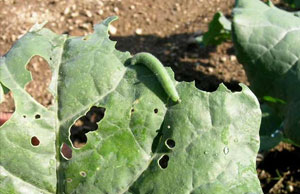  |
| Imported cabbage worm |
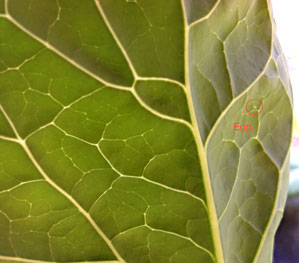 |
| Cabbage worm egg, circled in red. |
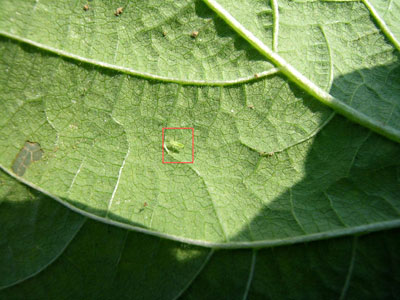 |
| Leafhopper nymph |
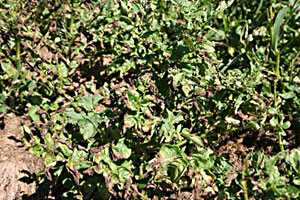 |
| Leafhopper hopperburn on potato leaves |
IMPORTED CABBAGE WORM
The white butterflies are flying all around the cabbage family plants now and laying eggs, and the larvae (green caterpillars) are now chewing holes in the leaves. If you have heading broccoli or cabbage you must know your customers because some folks are really turned off by the critters floating to the top of the water in the cooking pot. You may want to spray even though the crop is beyond risk.
This pest overwinters as a pupa and there are 3-4 generations per year. This means that once you start seeing the butterfly you should start scouting for the caterpillar in about a week. Bt (Dipel 2X or Dipel DF) or Entrust work very well in controlling the caterpillar. None of these materials lasts in the field and so should only be sprayed when the caterpillars are there in large enough numbers to warrant it.
Destroy or bury crop residue after harvest so as not to allow the caterpillars to continue to feed and complete their life history and thus a larger second generation later in the season.
Diamondback moth is also here. I have never seen them here so early (two weeks ago here in NH!). This pest is not supposed to overwinter in New England, but with all the high tunnels around I think lots of pests that are not supposed to spend the winter here have found a safe harbor. The same materials used for the imported cabbage worm will work to manage the diamondback moth.
Top
POTATO LEAFHOPPER
Potato Leafhoppers (PLH) have made it to New Hampshire and probably Maine. The adults are in big numbers in some fields, which may be very bad news. They are likely to be moving north so be on the lookout. They primarily feed on beans, potatoes, eggplants, strawberries and alfalfa. Worst for me is that they also feed on peanuts, one of my favorite crops. PLH do not overwinter anywhere near here. They overwinter way down south and leapfrog up here in mass migrations. The first to arrive are females, and they are usually carrying fertilized eggs when they get here. Then there are a few generations over the growing season before the cold north winterkills them.
The damage from leafhopper is catastrophic. The bug sucks the juice out of the plant and injects a toxin that clogs the food conducting tissue. The symptoms look like a disease after a while, rather than insect damage, and is frequently mistaken as such. The leaves first get pale, then yellow and then brown from the edges. Then the plant dies. The symptoms are called hopper burn.
The adult PLH is very light green and wedge shaped and tiny (an eighth of an inch long). The best way to find them is to brush the plant and watch one of the white-looking bugs land. The nymphs are similar to the adult, but have no wings and are even smaller and live on the underside of the leaves. If you disturb a nymph you will see it run and it can run sideways as fast as forward. This is a clue that you have PLH and not some other less harmful leafhopper.
The adults are flighty. When you brush your crop you will see them fly up. If there is a cloud of them, you are in trouble. Researchers have developed a threshold before treatment is recommended. Thresholds vary but here is one that is typical: Treat potatoes if 5 adults or 15 large larvae are found on 50 leaves.
Crop rotation does nothing for you since they are coming from far away. Covering your crops with a row cover would work, but these crops are not the type that is usually covered. Effective insecticides are limited. The only material that I have seen work that is allowed in organic production is pyrethrum, so Pyganic is the recommendation that I make. However, it does not work as well as a pyrethrum with PBO, BUT PBO is not permitted in organic production. If you market crops as organic, be sure to use an approved brand. Use the most concentrated mix allowed. Spray late in the day or evening, get good coverage including the undersides of the leaves, and don’t wait until it is too late.
Top
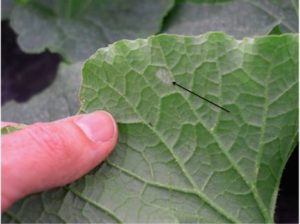  |
| Powdery mildew |
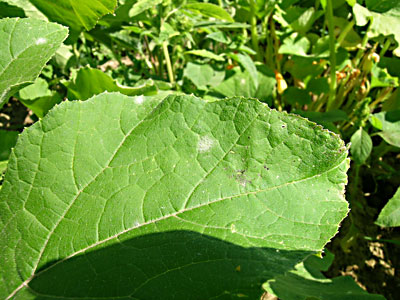 |
| Powdery mildew on the top surface of a pumpkin leaf |
POWDERY MILDEW
Powdery mildew is a common disease of pumpkins and winter squash. All cucurbits are susceptible, but many common cucumber and melon varieties are resistant. The disease can cause infected leaves to die prematurely, reducing yields and lowering fruit quality, especially taste. Winter squash from diseased plants won’t store as long as fruits from healthy plants. The fungus that causes the disease does not overwinter in Maine. Spores blow up every year from southern overwintering sites. If they arrive late in the season, you may not need any control; but if they arrive in early to midsummer, exercise some control or you may have no leaves by mid-August, or bland starchy squash.
I have not seen any yet. Go out and scout. Check upper and lower surfaces of leaves of older plants every few days starting now. The first symptoms usually are white, powdery fungal patches on the undersides of older leaves. Yellow spots may form opposite these, on the upper leaf surfaces.
No products with systemic activity (products that move through the plant) are approved for organic production, and applying fungicide to the lower leaf surface is difficult. In experiments, foliar applications of sulfur have been more effective than most other organic products for powdery mildew, apparently because sulfur deposited on the upper leaf surface can volatilize and be redistributed to the lower surface. Sulfur can be phytotoxic on melons, especially if applied when temperatures are hot.
There are some new products made from potassium bicarbonate (Kaligreen and Milstop are two of these) that are showing good efficacy. For a good discussion of these, including efficacy, see the new edition of the Resource Guide to Organic Insect and Disease Management at: https://web.pppmb.cals.cornell.edu/resourceguide/
ATTRA (National Sustainable Agriculture Information Service, https://www.attra.ncat.org) reports that a single spray application (to runoff) of 0.5 percent (wt./vol. of water) baking soda, plus 0.5 percent (vol./vol. of water) SunSpray UFP® horticultural oil almost completely inhibited powdery mildew on heavily infected pumpkin foliage; while baking soda without the oil was ineffective, and a 2 percent (wt./vol. of water) solution of baking soda damaged the leaves.
Top
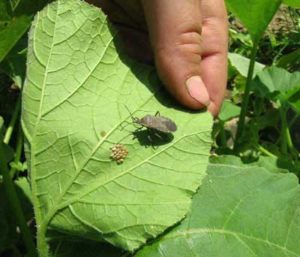  |
| Squash bug adult and eggs |
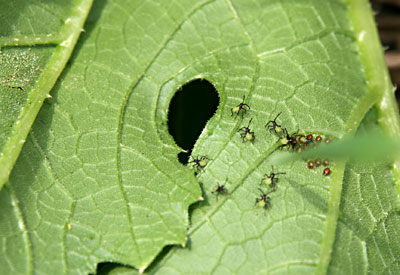 |
| Squash bug hatch |
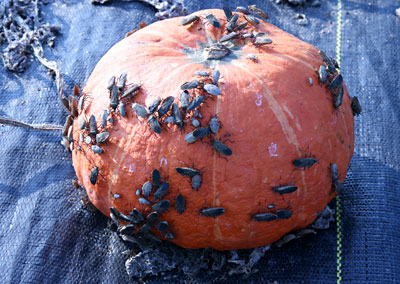 |
| Squash bug adults and older nymphs |
SQUASH BUG
Squash bugs are bound to show up soon. I have seen some eggs already. Squash bugs are serious pests of pumpkins and squash throughout North America. Damage and survival are low on watermelon, very low on cucumber and muskmelon, and highest on squash and pumpkin. Both adults and nymphs feed by inserting their beak and sucking juices from plant tissue. Toxic saliva injected during feeding causes foliage to wilt, then leaves turn black and die; the severity of this damage is directly related to density of squash bugs on each plant. Often I get calls by growers who believe they have a disease. Later in the season, squash bugs may feed on the fruit, causing them to collapse or become unmarketable.
Adults are 0.5 to 0.75 of an inch long, flattened and grayish-brown. They hibernate in trash in and around the garden for the winter and emerge in the early summer to feed a bit and lay eggs. Eggs are laid in clusters usually on the underside of leaves and are orange when first laid, but turn bronze-colored before they hatch. The wingless nymphs are similar in appearance to adults, and are whitish when small, with a brown head, and grayish white when larger with black legs. There is one generation per year in the Northeast.
Black plastic, straw mulch, and reduced tillage systems encourage higher populations, probably by providing good hiding places. Squash bug numbers are reduced by clean cultivation in the fall, and crop rotation. Infestation is delayed by row covers. If possible, rotate cucurbit crops between fields as far apart as possible. Keep headlands mowed and free of trash to reduce overwintering sites.
Squash bugs are unusually difficult to control with insecticides. Scout undersides of leaves for squash bug adults and eggs. Crush the eggs. You may not want to crush the bugs as they stink when you do.
If you miss some eggs and have to spray, time squash bug sprays to kill young nymphs just after hatch, because this stage is the easiest to control. Treat late in the day when the flowers are closed to reduce risk to bees. Neem products have proved effective.
For adult bug control, insecticides applied to the base of the plant are most effective, possibly because bugs tend to cluster. But, squash bugs are virtually impossible to control later in the season when nymphs are large and the canopy is dense.
(Source material from New England Vegetable Management Guide; Handbook of Vegetable Pests, A Capinera; ATTRA. Adapted by Andy Cavanagh & R Hazzard, UMass Extension, and modified for this Pest Report by me)
Top
